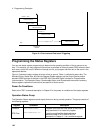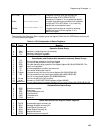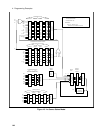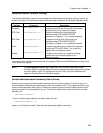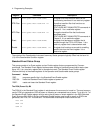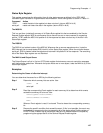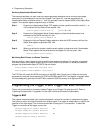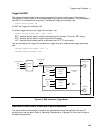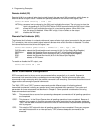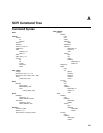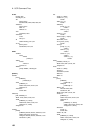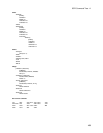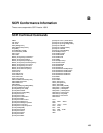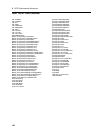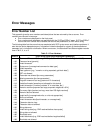
4 - Programming Examples
150
Remote Inhibit (RI)
Remote inhibit is an external logic signal routed through the rear panel INH connection, which allows an
external device to signal a fault. To select an operating modes for the remote inhibit signal, use:
OUTPut:RI:MODE LATChing | LIVE | OFF
LATChing -causes a low-true signal on the INH input to disable the output. The only way to clear the
latch is by sending an OUTPut:PROTection:CLEAR command while the INH input is false.
LIVE - allows the RI input to disable the output in a non-latching manner. When INH is low
true, the output is disabled. When INH is high, it has no effect on the output.
OFF - disables the INH input.
Discrete Fault Indicator (DFI)
The discrete fault indicator is a chassis-referenced, open-collector logic signal connected to the rear panel
FLT connection, that can be used to signal external devices when a fault condition is detected. To select
the internal fault source that drives this signal, use:
OUTPut:DFI:SOURce QUEStionable | OPERation | ESB | RQS | OFF
QUEStionable - selects the Questionable event summary bit (bit 3 of the Status Byte Register)
OPERation - selects the Operation Event summary bit (bit 7 of the Status Byte Register)
ESB - selects the Standard Event summary bit (bit 5 of the Status Byte Register)
RQS - selects the Request Service bit (bit 6 of the Status Byte Register)
OFF - selects no DFI source
To enable or disable the DFI output, use:
OUTPut:DFI:STATe ON | OFF
SCPI Command Completion
SCPI commands sent to the ac source are processed either sequentially or in parallel. Sequential
commands finish execution before a subsequent command begins. Parallel commands allow other
commands to begin executing while the parallel command is still executing. Commands that affect list and
trigger actions are among the parallel commands.
The *WAI, *OPC, and *OPC? common commands provide different ways of indicating when all
transmitted commands, including any parallel ones, have completed their operations. The syntax and
parameters for these commands are described in Chapter 3. Some practical considerations for using
these commands are as follows:
*WAI - This prevents the ac source from processing subsequent commands until all pending operations
are completed.
*OPC? - This places a 1 in the Output Queue when all pending operations have completed. Because it
requires your program to read the returned value before executing the next program statement,
*OPC? can be used to cause the controller to wait for commands to complete before proceeding
with its program.
*OPC This sets the OPC status bit when all pending operations have completed. Since your program
can read this status bit on an interrupt basis, *OPC allows subsequent commands to be
executed.



